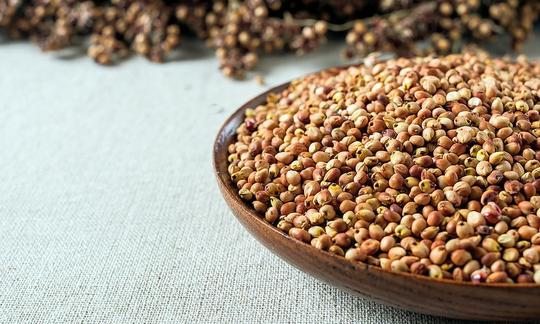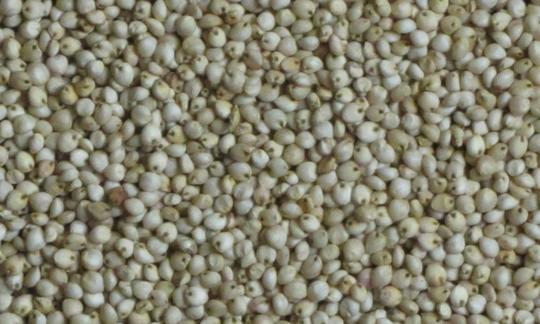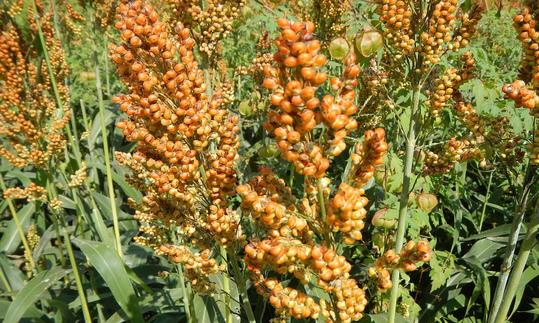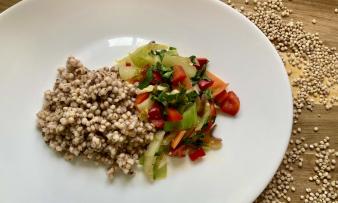Table of contents
Sorghum millet ( Sorghum bicolor), often also called sorghum, sorghum or sweet millet, is becoming increasingly important as a gluten-free grain in western countries. In the kitchen, sorghum grain is usually used cooked or processed into flour, but it can also be prepared raw (preferably in organic quality).
Using sorghum millet in the kitchen:
What is sorghum? The term sorghum millet refers to various species of the genus Sorghum, with the species Sorghum bicolor being the most cultivated and therefore economically most important representative of the genus. Sorghum bicolor is colloquially referred to as sorghum millet - this is slightly confusing, as this term basically includes all species of the Sorghum genus. In this article, we focus on the species Sorghum bicolor and use its name "sorghum millet".
The taste of sorghum millet is nutty and slightly sweet. Sometimes there is a bitter aftertaste, which can be explained as follows: The dehulling or grinding process damages the germ, which can lead to the release of germ oil. This oil oxidizes very easily in the air, which can result in a slightly bitter taste. If you want to remove these traces of oil before preparing the sorghum, rinse the sorghum grains briefly with lukewarm water. If you want to use raw sorghum millet, rinsing is not recommended, as the grains are more susceptible to mold and are also more difficult to grind. However, these oil residues are neither harmful nor toxic, so there is basically no need for action - unless you find the taste unpleasantly bitter. If you want to eat sorghum raw, you can find more information about it under the ingredient common millet (raw) or in the article phytic acid or phytate and soaking or sprouting.
In West Africa, sorghum is a valuable grain and staple food that is eaten boiled, similar to rice, or fried to make a kind of popcorn. If it is ground into semolina, it can be used to make porridge (tô) or groats. In some parts of India, sorghum flatbread is often eaten with vegetable curries. In Africa, sorghum is also used to brew gluten-free beer. The lactic acid-fermented drink tastes sour, is rich in protein and is a good thirst quencher. 1 In South Africa it is known as umqombothi, in West Africa as dolo, in East Africa as pombe and in Sudan it is called merisa. In China, people drink maotai, a liquor made from sorghum.
Cooked sorghum tastes wonderful in vitamin-rich Buddha bowls, nutritious salads (e.g. with chickpeas and pomegranate seeds in a fruity-minty dressing or with fresh tomatoes in a kale pesto), vegetable stir-fries and casseroles. Sorghum also tastes particularly good as a vegan pilaf instead of rice (e.g. with sweet potatoes, pumpkin or asparagus), in chili sin carne or as part of a creamy soup (e.g. with mushrooms). You can also prepare the cooked grains together with chia, berries and soy yoghurt to make a delicious breakfast bowl, or add the popped grains to all kinds of desserts and shakes.
Sorghum is also available as flour. This is not good for baking on its own. However, you can mix the gluten-free sorghum flour with other flours and use it to make bread, flatbread, cakes, cookies and other baked goods.
Sweet sorghum is a variety of Sorghum bicolor that contains a lot of sugar and is used to produce molasses and syrup. Sorghum syrup can be used like maple syrup, for example for pancakes.
Vegan recipe for oriental sorghum millet salad:
Ingredients (for 4 people): 150 g sorghum millet (raw, organic), 1 can of cooked chickpeas (approx. 400 g), 4 spring onions, 2 carrots, 1 bunch of parsley, ½ lemon, 1 clove of garlic, 4 tbsp rapeseed oil, 1 tsp date syrup or agave syrup, ½ tsp cumin (ground), ½ tsp paprika powder (sweet), 1 pinch of cayenne pepper, a little salt, 50 g cranberries, 30 g raw pistachios.
Preparation: Cook the sorghum millet according to the instructions on the packet and allow to swell. Loosen and allow to cool. Rinse the canned chickpeas briefly and drain. Clean the spring onions and cut into rings. Peel the carrots and cut into strips. Rinse the bunch of parsley, shake dry and chop roughly. For the salad dressing, squeeze half a lemon. Peel the garlic clove and press it or chop it finely. Mix 2 tablespoons of the fresh lemon juice with garlic, rapeseed oil, date or agave syrup and season with cumin, paprika and cayenne pepper. Season with a little salt. Pour the cooled sorghum millet into a bowl and add the chickpeas, spring onion rings, parsley and cranberries. Mix the dressing into the salad. Sprinkle the pistachio nuts over the vegan sorghum millet salad and serve. If you like, you can serve it with soy yoghurt and flatbread.
Vegan recipes with sorghum can be found under the note: " Recipes that have the most of this ingredient ".
| Not only vegans or vegetarians should read this: Vegans often eat unhealthily. Avoidable nutritional errors. |
Shopping - where to buy sorghum millet?
Most supermarkets (e.g. Coop, Migros, Denner, Volg, Spar, Aldi, Lidl, Rewe, Edeka, Hofer) and even organic supermarkets (e.g. Alnatura, Denn's Biomarkt) do not sell sorghum millet. You are most likely to find it in health food stores or online shops.
When you find sorghum grains in stores, they are usually dehulled. Sorghum has significantly larger grains (4-8 mm in diameter) than common millet. Is sorghum red? Sorghum seeds can vary greatly in color. The seeds appear white, yellow or red. However, millet and sorghum are not always clearly distinguishable.
Found in the wild - Wild sorghum:
There are two wild subspecies of Sorghum bicolor : Sorghum bicolor subsp. drummondii and Sorghum bicolor subsp. verticilliflorum. These are native to Africa and occur there as annual weeds. They are very similar to the cultivated varieties. 2
Storage:
When stored in a dry, airtight place and protected from light, sorghum grains will last a very long time - similar to other grains. Gluten-free flour, on the other hand, spoils very easily, so it should be used quickly. You may be able to find preserved sorghum flour, but this has at least been through a heating process.
Ingredients - Nutritional values - Calories:
Sorghum millet (raw) contains 329 kcal per 100 g. The majority of the calories come from carbohydrates (72 g/100g). The grains are rich in fiber (6.7 g/100g; 26.8% of the daily requirement). The protein content is also significant at 11 g/100g - comparable to that of millet (11 g/100g), hulled barley (12 g/100g), wheat grains (10 g/100g) and rye grains (10 g/100g). The protein is very easily digestible and is largely made up of essential amino acids 3 - e.g. leucine (1.5 g/100g; 62% of the daily requirement) and tryptophan (0.12 g/100g; 50% of the daily requirement). 100 g of sorghum also contains 3.5 g of fat. 4
100 g of raw sorghum contains 1.6 mg of manganese - that's 80% of the daily requirement. In addition to millet (1.6 mg/100g) , lentils (1.4 mg/100g) have a similar content. Raw chickpeas contain slightly more manganese at 2 mg/100g. 4
The magnesium content is 165 mg/100g (44% of the daily requirement). This is similar to that of oats (177 mg/100g) and medium-grain brown rice (143 mg/100g). Unpeeled hemp seeds are particularly rich in magnesium with 700 mg/100g. 4
In addition to important amino acids and minerals, raw sorghum also contains vitamins. For example, it contains 0.44 mg of vitamin B6 (pyridoxine) per 100 g (32% of the daily requirement). Quinoa (0.49 mg/100g) and teff (0.48 mg/100g) contain similar amounts of pyridoxine. With 1.7 mg/100g, pistachios are particularly good sources of vitamin B 6. 4
The complete ingredients of sorghum millet, the coverage of the daily requirement and comparison values with other ingredients can be found in our nutrient tables. In the article Nutrients explained you will get a detailed insight into the topic.
Health aspects - effects:
Is sorghum gluten-free? The grain is gluten-free and therefore ideal for people with gluten intolerance (celiac disease).
Is sorghum healthy? According to in vitro studies, the bioactive compounds contained in sorghum have a positive influence on the gut microbiota and counteract obesity, inflammation, diabetes, dyslipidemia, hypertension and cancer. However, more research is needed on this. 5,6 Another study draws particular attention to the antioxidant, immunomodulatory and anti-cancer effects and emphasizes that the bioactive substances in sorghum could be promising for the prevention and possible treatment of colon cancer. 7
Dangers - Intolerances - Side effects:
In many countries in Africa and Asia, sorghum is an important staple food. A few studies indicate that mineral concentrations and bioavailability in cooked sorghum grain are limited. Micronutrient malnutrition can lead to blindness and anemia, for example. Therefore, there are efforts to biofortify sorghum - that is, attempts to improve the nutrient content (especially iron and zinc). 8
Folk medicine - natural medicine:
In traditional Chinese medicine ( TCM), the root of Sorghum bicolor is a herbal medicine called "Zhualong" or "Gaoliangqi". It is said to relieve asthma, promote urination (diuretic) and stop bleeding. It is also used as a folk medicine for treating coughs. 9
Occurrence - Origin:
Sorghum millets originally come from Africa. It was also domesticated there for the first time. 5,10 At the beginning of the 17th century, sorghum reached the USA as a feed grain - today it is the largest producer and exporter of sorghum 6. Thanks to many breeding processes, there are now hybrid varieties that are very productive and have large grains. They grow low and ripen evenly. 11 Sorghum is the fifth most important food grain in the world (after wheat, rice, corn and barley 5) and is cultivated in all warm, tropical and subtropical regions of the world. 11 This is due, among other things, to its ability to grow on poor soils in water-poor areas. 12
Sorghum: Cultivation - Harvest:
Sorghum grows very similarly to corn, but has more side shoots and roots much deeper (up to 1.2 m). There are cultivated forms that reach a height of over 5 m. The waxy coating on the leaves and stems makes it possible to store water even for longer periods of drought, which is ideal for dry and semi-dry locations. 1
Sorghum is extremely drought tolerant. During very dry periods, the sorghum plant remains in a state of dry dormancy, from which it awakens again after the first rains. It is obvious that sorghum millet does not like cold soil and is very sensitive to frost. 13
General information:
Sorghum ( Sorghum bicolor) belongs to the family of sweet grasses (Poaceae). The subfamily Panicoideae also includes other millet genera and species, such as the genera Pennisetum (pennisetum including the Pearl millet) and Panicum (millet). The subfamily Chloridoideae includes finger millet, for example. But there are also grass weeds that are referred to as millet (e.g. barnyard millet).
For agricultural use, different types of sorghum are distinguished: Sudan grass (cross between Sorghum bicolor and Sorghum sudanense), sweet sorghum, fiber sorghum, fodder sorghum and grain sorghum. 13
Alternative names:
Other names used for sorghum millet are: real sorghum, sorghum, sweet millet, dari (Persian language sweet millet), sorgho, durra grain, broom grain, kaffir grain, guinea grain, shallu, milo or jowar. Incorrect spellings such as sorghum millet, sorgum, sorgum millet or sorghun creep in.
In English, sorghum is called sorghum, great millet, milo, durra, broomcorn or guinea corn.
Key words on sorghum use:
In addition to its use as food, sorghum has developed into an important fodder crop (silage sorghum, grain sorghum). 10 In addition, some sorghum varieties are also suitable for the production of brooms, ethanol, paper, building materials and biofuels. 9,14
Literature - Sources:
Bibliography - 14 Sources
| 1. | Getreide.org Sorghum. |
| 2. | Digibib.hs-nb.de Sorghum bicolor (L.) Moench. |
| 3. | Franke W. Nutzpflanzenkunde. 5. Auflage. Stuttgart: Thieme-Verlag; 1992. |
| 4. | USDA United States Department for Agriculture. |
| 5. | de Morais Cardoso L, Pinheiro SS, Martino HSD, Pinheiro-Sant’Ana HM. Sorghum (Sorghum bicolor L.): Nutrients, bioactive compounds, and potential impact on human health. Crit Rev Food Sci Nutr. 2017;57(2):372–90. |
| 6. | Awika JM, Rooney LW. Sorghum phytochemicals and their potential impact on human health. Phytochemistry. 2004;65(9):1199-221. |
| 7. | Vanamala JKP, Massey AR, Pinnamaneni SR, Reddivari L, Reardon KF. Grain and sweet sorghum (Sorghum bicolor l. Moench) serves as a novel source of bioactive compounds for human health. Crit Rev Food Sci Nutr. 2018;58(17):2867–81. |
| 8. | Ashok Kumar A, Reddy BVS, Ramaiah B. Biofortification for combating micronutrient malnutrition: Identification of commercial sorghum cultivars with high grain iron and zinc concentrations. Indian Journal of Dryland Agricultural Research and Development. 2013;28(1):89–94. |
| 9. | Zhou Q, Liang D, Deng A, Zhang J, Wu C, Nie Z, u. a. Antitussive, expectorant and bronchodilating effects of ethanol extract of Sorghum bicolor (L.) Moench roots. J Ethnopharmacol. 2013;149(1):297–302. |
| 10. | Brücher H. Tropische Nutzpflanzen. Ursprung, Evolution und Domestikation. Springer-Verlag Berlin Heidelberg: New York; 1977: 76-9. |
| 11. | Rehm S, Espig G. Die Kulturpflanzen der Tropen und Subtropen. Anbau, wirtschaftliche Bedeutung, Verwertung. Stuttgart: Eugen Ulmer Verlag; 1976. |
| 12. | Pini U. Das Bio-Food Handbuch. Ullmann Verlag: Potsdam; 2014: 323. |
| 13. | Pflanzenforschung.de Hirse Sorghum bicolor. |
| 14. | Agrarforschungschweiz.ch Körnersorghum – eine in der Schweiz noch unbekannte, interessante Ackerkultur. |













Comments